Istanbul’s culinary scene is a journey through time and tradition. From bustling street food to rooftop feasts, every bite tells a story.
Few cities in the world offer a food experience as rich and diverse as Istanbul. Here, centuries of history unfold on your plate—Ottoman banquets, Mediterranean freshness, and Central Asian spice routes converge in kitchens, markets, and humble street stalls. As you wander its vibrant neighbourhoods, you’ll notice how food is woven into every aspect of daily life—from the hiss of street-side grills to the clink of tulip-shaped tea glasses in quiet cafés. Istanbul isn’t just a place to eat; it’s a city that feeds your senses.
For the globally curious traveller, Istanbul’s culinary offerings are more than just sustenance. They’re a window into cultural traditions, social rituals, and stories passed down through generations. Whether you’re devouring fresh balık ekmek by the Bosphorus or sipping a strong cup of Turkish coffee in a hidden courtyard, each moment connects you more deeply to the city’s soul. In this guide, we dive into Istanbul’s rich food culture—from time-honoured dishes and bustling markets to sweet indulgences and sustainable eats.
Istanbul’s culinary heritage: A feast for the senses
Every dish carries a legacy, from the intricate layers of baklava to the humble yet iconic döner. Whether you’re wandering through bustling markets or dining in a rooftop restaurant overlooking the Bosphorus, Istanbul’s food culture promises an unforgettable experience.
The influence of Ottoman cuisine
The Ottoman Empire left an indelible mark on Istanbul’s culinary traditions, introducing refined techniques and rich flavours. Dishes like slow-cooked lamb stews, aromatic pilafs, and syrup-drenched desserts such as baklava and lokum (Turkish delight) remain staples today.
Key elements of Ottoman-inspired dining:
- Slow-cooked meats: Lamb and beef, marinated in spices like cumin and sumac.
- Rice dishes: Often paired with nuts, dried fruits, and saffron.
- Sweet indulgences: Baklava, künefe, and helva, showcasing the empire’s love for layered pastries and honeyed treats.
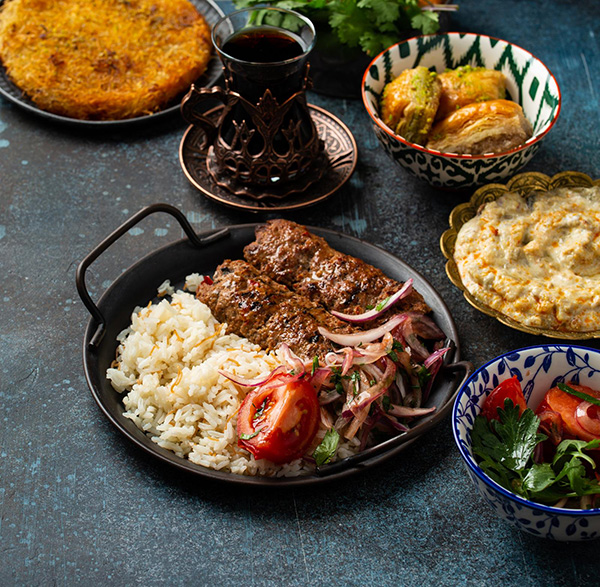
Mediterranean and Middle Eastern flavours
Thanks to its geography, Istanbul’s cuisine also embraces fresh, vibrant Mediterranean ingredients. Olive oil, citrus, and seafood play starring roles, while herbs like mint, parsley, and dill add brightness to meze platters.
A few standout ingredients:
| Ingredient | Common Uses |
|---|---|
| Olive oil | Salads, dips, and grilled dishes |
| Eggplant | İmam bayıldı (stuffed eggplant), karnıyarık |
| Yogurt | Cacık (tzatziki), marinades, and desserts |
Spices: The heart of Turkish cooking
No exploration of Istanbul’s food is complete without diving into its spice culture. From the fiery red flakes of pul biber to the warm sweetness of cinnamon, spices define the city’s flavour profiles.
Must-try spice blends:
- Baharat: A mix of cumin, paprika, and black pepper, often used in kebabs.
- Sumac: A tangy, citrusy sprinkle for salads and grilled meats.
- Saffron: Prized for its floral aroma, used in pilafs and desserts.
Street food delights: Flavours on the go
Istanbul’s streets are an open-air buffet, offering everything from crispy simit to succulent balık ekmek (fish sandwiches). Here’s where to start:
Simit & çay: The ultimate Turkish breakfast
A sesame-crusted bread ring, crunchy on the outside and soft on the inside, paired with çay—strong, black Turkish tea —is the quintessential Istanbul breakfast. Vendors sell simit from red carts across the city, making it an easy grab-and-go option.
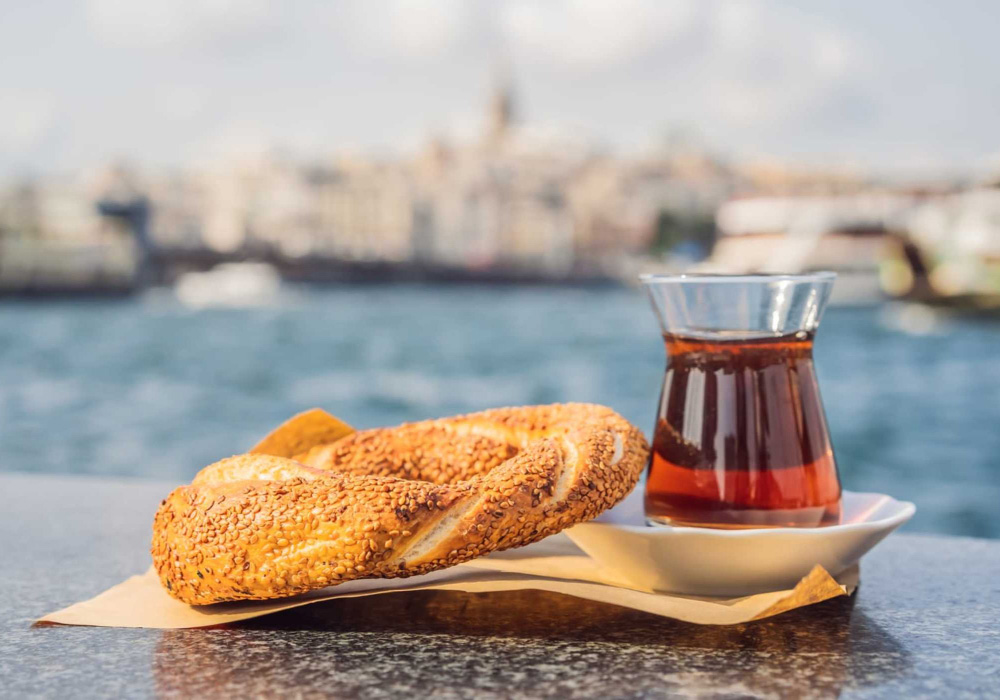
Why locals love it:
- Affordable: Typically costs around 5 TL.
- Everywhere: Found in red carts on nearly every street.
- Versatile: Eaten plain or with cheese, olives, or jam.
Döner & kebabs: Meat lover’s paradise
These meat-forward dishes are street food royalty. Döner, slow-cooked on a vertical spit, is served in wraps or on plates, while kebabs offer a variety of flavours and spices.
- Adana kebab: Spicy minced lamb.
- Shish kebab: Marinated cubes grilled on skewers.
- Iskender kebab: Döner over bread, topped with tomato sauce and yogurt.

Balık Ekmek: A taste of the sea
Sold near Galata Bridge, this fish sandwich is the epitome of Istanbul’s coastal influence. Grilled mackerel, crisp vegetables, and fluffy bread come together in a portable meal.
- Fresh: Often prepared with same-day catch.
- Quick: Ideal for travellers on the move.
- Healthy: A lighter alternative to meat-based options.
Best street food neighbourhoods
In a city as vast and dynamic as Istanbul, every neighbourhood offers its own distinct culinary personality. From the Asian side to the historic heart of the European quarter, the diversity of street food reflects the character of each district. Whether you're looking for quick bites in a student-friendly area, seafood with a waterfront view, or a bustling local market brimming with tradition, Istanbul’s neighbourhoods serve up flavours that capture the spirit of the city. Here are some of the top spots to indulge your street food cravings:
- Kadıköy Market: Diverse, local, and bustling.
- Eminönü Square: The go-to for balık ekmek.
- Taksim Square: Central hub with kebabs galore.
- Beşiktaş Market: Simit and snacks in a lively student area.
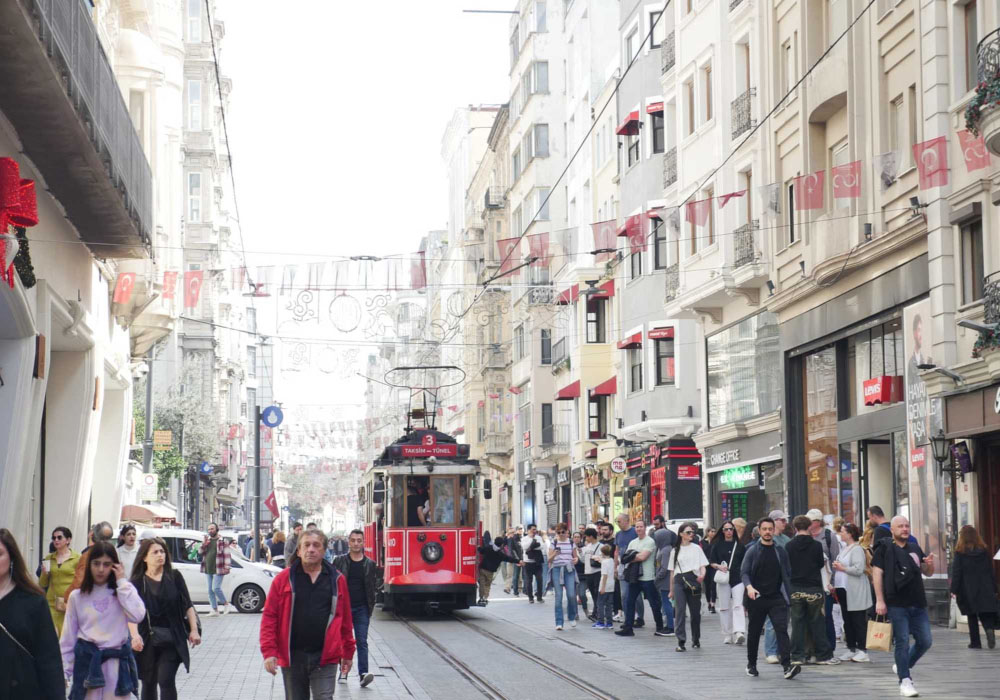
Traditional dishes: Icons of Turkish cuisine
Istanbul’s culinary legacy is rooted in dishes that have stood the test of time. Passed down through generations, these traditional recipes are cherished for their flavour, cultural symbolism, and power to bring people together. Whether enjoyed at a family dinner, during festive celebrations, or in a bustling meyhane (Turkish tavern), these dishes form the backbone of the city’s rich gastronomic heritage. They reflect not just ingredients and techniques, but shared rituals and stories that define Istanbul’s identity.
Meze platters
Meze are much more than appetizers—they are a cornerstone of Turkish hospitality. These small, flavour-packed dishes are often the prelude to a larger meal but are also perfect for casual grazing with friends over drinks. Served hot or cold, meze platters offer a colourful mosaic of textures and tastes that invite conversation and connection.
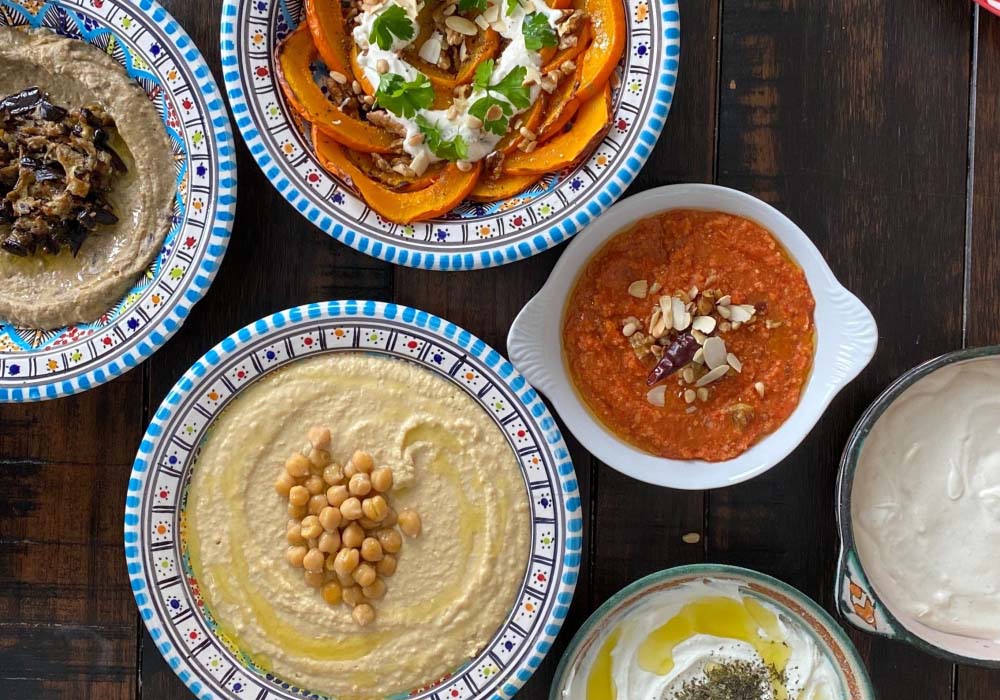
- Hummus: A velvety blend of chickpeas, tahini, lemon, and garlic, often topped with olive oil or paprika.
- Ezme: A fiery, finely chopped tomato and pepper relish spiked with chilli and pomegranate molasses.
- Dolma: Grape leaves or vegetables like zucchini and peppers stuffed with rice, pine nuts, and aromatic herbs.
Meze platters are typically shared, encouraging a relaxed, communal style of dining. From tangy to creamy, every dish offers a unique taste experience at the table.
Köfte and pide
Two beloved staples of Turkish cuisine, köfte and pide, are found everywhere, from street stalls to sit-down restaurants. Köfte are seasoned meatballs made with ground beef or lamb, combined with spices like cumin, paprika, and mint. They’re grilled or pan-fried and served with rice, salad, or flatbread.
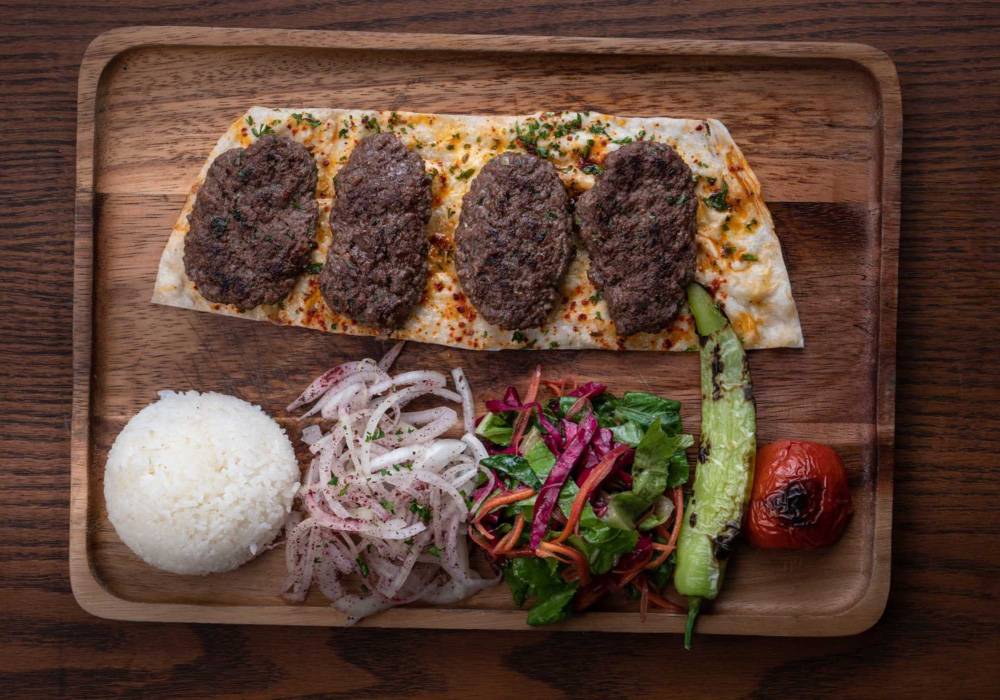
Pide, often referred to as Turkish pizza, is a flatbread shaped like a boat and baked in a stone oven. The dough is soft and chewy inside, with crisp, golden edges, and is topped with a variety of ingredients, including minced meat, melting cheeses, and vegetables.
- Popular fillings: Ground beef and onion, spinach and feta, or sujuk (Turkish sausage) with egg.
- Texture: Crusty on the outside, pillowy and rich within.
Together, köfte and pide represent the comfort and warmth of everyday Turkish home cooking.
Dolma and sarma
Few dishes evoke the generosity and care of Turkish cuisine like dolma and sarma. These “stuffed” and “wrapped” creations are time-intensive but deeply rewarding, often prepared for family feasts or special occasions.
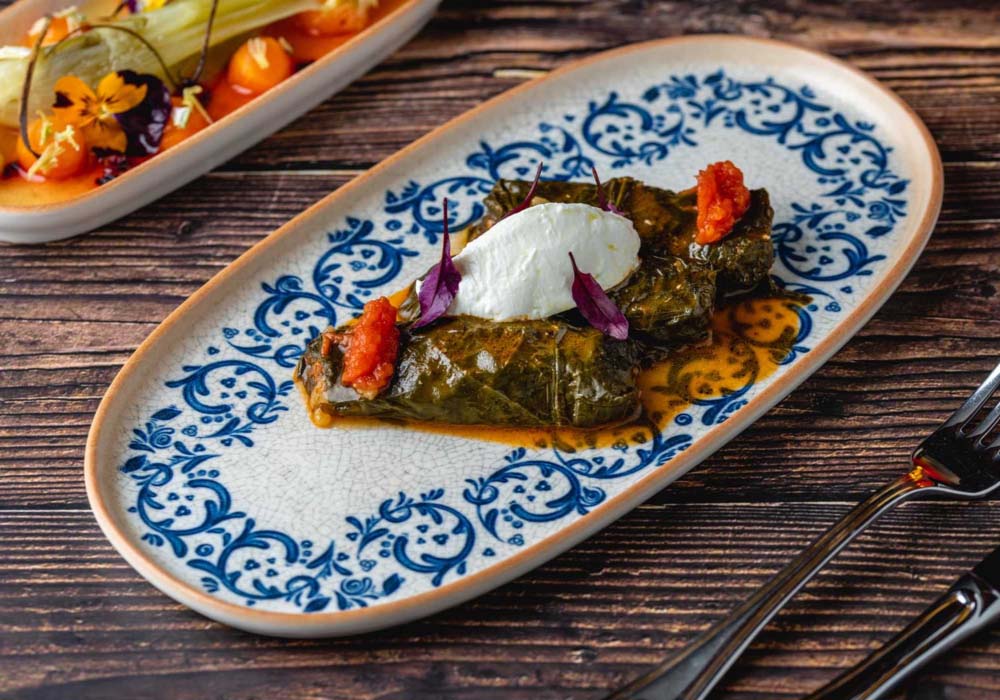
Dolma refers broadly to any vegetable that’s hollowed out and filled with a savoury mix—usually rice, pine nuts, currants, and herbs like dill or parsley. Bell peppers, tomatoes, eggplants, and zucchinis are commonly used.
Sarma, on the other hand, typically uses grape or cabbage leaves to encase the filling. Grape leaf sarma is tangy and fragrant, often served cold with a drizzle of olive oil and a squeeze of lemon.
- Vegetable dolma: Tender peppers or tomatoes stuffed with seasoned rice and gently stewed until soft.
- Grape leaf sarma: Rolled tightly and bursting with lemony rice and herbs, perfect as part of a meze spread or as a standalone snack.
Each family often has its own version of dolma or sarma, passed down through generations—a testament to their enduring appeal and cultural significance. These dishes showcase the balance of flavour and technique that defines traditional Turkish cooking.
Sweet treats: Istanbul’s dessert culture
No culinary journey through Istanbul is complete without indulging in its dazzling array of desserts. Sweets are more than just a conclusion to a meal—they’re a vital part of Turkish hospitality, offered to guests as a gesture of warmth and generosity. Rooted in centuries-old traditions, Istanbul’s desserts range from delicately flaky to decadently syrupy, and from chewy to creamy. These confections reflect the city’s multicultural influences and its love for finely balanced textures and flavours.
Whether enjoyed with a cup of strong Turkish coffee or as a standalone treat in a bustling pastry shop, each dessert offers a moment of delight—and a deeper connection to Istanbul’s rich culinary heritage.
Baklava
Perhaps the most iconic of Turkish desserts, baklava is a sweet, multilayered pastry made with paper-thin phyllo dough, crushed nuts, and sweet syrup or honey. Originating in the kitchens of the Ottoman Empire, baklava is now a staple in homes and pastry shops throughout the city.
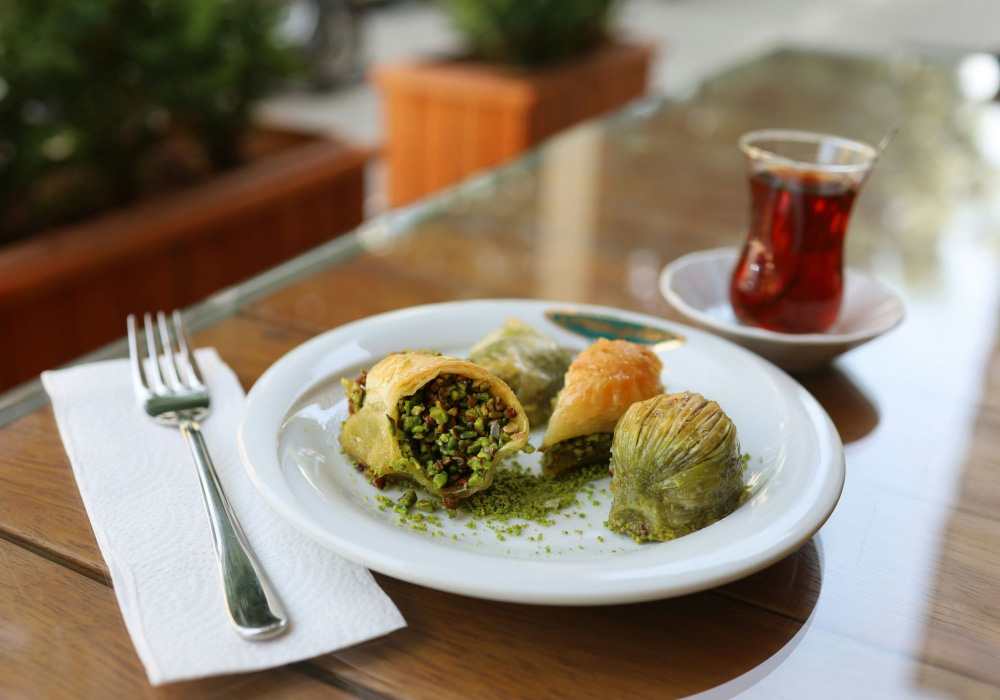
There are many regional variations, but Istanbul’s offerings are especially indulgent, often made with high-quality ingredients and meticulous technique. The phyllo is brushed with butter between each layer, then baked to a golden crisp and drenched in aromatic syrup after baking.
| Type | Main Ingredient | Flavour |
|---|---|---|
| Traditional | Walnuts | Syrupy, nutty |
| Pistachio | Pistachios | Rich, aromatic |
| Chocolate | Cocoa layers | Sweet, indulgent |
- Traditional Baklava: Made with walnuts and sweet syrup, offering a satisfying crunch and deep nutty flavour.
- Pistachio Baklava: A luxurious variation using premium pistachios for a vibrant green filling and intense flavour.
- Chocolate Baklava: A modern twist combining classic textures with chocolatey richness for a unique fusion treat.
Baklava is best enjoyed freshly made and paired with a strong cup of Turkish tea or coffee.
Turkish Delight (Lokum)
Turkish Delight, or lokum, is a soft, chewy confection that has enchanted sweet lovers for centuries. With its jewel-like appearance and variety of flavours, it is one of Turkey’s most beloved and recognizable treats.

Made from sugar, starch, and flavourings, lokum is often dusted with powdered sugar and sometimes filled with nuts, such as pistachios or hazelnuts. It’s a treat commonly offered during holidays and celebrations and is traditionally served alongside Turkish coffee to complement its bold taste.
- Rose: The most classic flavour, with floral notes and a silky chew.
- Lemon: Bright and citrusy, offering a refreshing contrast to richer desserts.
- Pomegranate: A contemporary favourite with a sweet-tart profile and vibrant hue.
Lokum is more than just candy—it’s a piece of Turkish history wrapped in sweetness. Its presence in social rituals makes it a cultural treasure that continues to charm locals and travellers alike.
Künefe
For those who crave something warm, gooey, and utterly indulgent, künefe is the dessert to seek out. Originating from the southeastern regions of Turkey, this dessert has made its way into the heart of Istanbul and is served in many traditional eateries and dessert cafes.
Künefe is made with shredded phyllo dough (called kadayıf), layered with a stretchy, unsalted cheese that melts into a creamy centre. Once cooked to a golden crisp, the entire dessert is soaked in syrup and topped with crushed pistachios for a final flourish of texture and colour.
| Component | Description |
|---|---|
| Phyllo dough | Golden brown, shredded, crispy |
| Cheese | Mild, melty, and slightly salty |
| Syrup | Sweet, fragrant, and sticky |
- Texture contrast: The outer shell is crisp and buttery, while the centre oozes with warm, melted cheese.
- Balance of flavours: The sweetness of the syrup is balanced by the savoury cheese and nutty garnish.
- Serving tradition: Typically cooked and served in individual round copper pans for an extra layer of authenticity.
Künefe is best eaten hot, often as a shared dessert after a hearty meal. It’s rich, decadent, and a must-try for those wanting to experience Turkish dessert craftsmanship at its most dramatic.
Turkish tea and coffee culture
Turkish tea and coffee are more than just refreshments in Istanbul. They are symbols of hospitality and social interaction. Tea and coffee play a significant role in daily life. They are served during gatherings, business meetings, and casual conversations. The preparation and presentation of these beverages are rituals deeply embedded in Turkish culture.
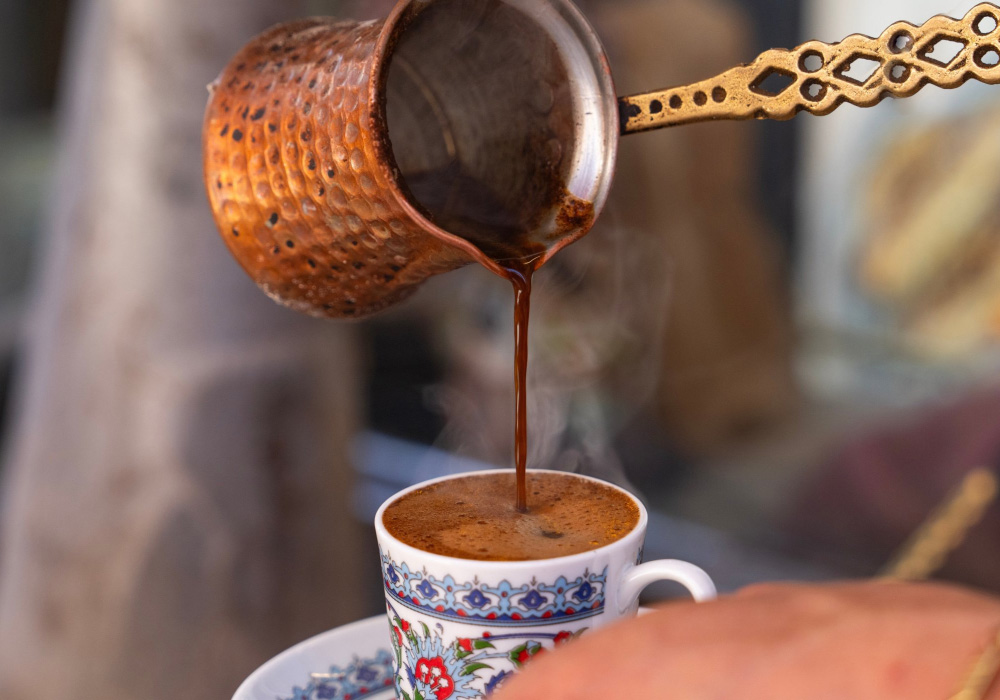
Tea is often served in tulip-shaped glasses, presenting its vibrant colour. Coffee, on the other hand, is brewed to perfection, delivering an intense flavour. Both beverages are accompanied by sweet treats or snacks, enhancing the overall experience.
In Turkish culture:
- Tea is a daily staple, consumed throughout the day.
- Coffee signifies friendship and hospitality, often served to guests.
This tradition highlights the significance of connection and warmth, making these beverages an integral part of Istanbul's social fabric.
Turkish tea
Turkish tea, known as "çay," as already mentioned above, is a cornerstone of Istanbul's culinary landscape. Made from black tea leaves, its preparation is a delicate process. Tea is brewed using two stacked kettles. The top kettle holds tea leaves, while the bottom contains boiling water.
This method creates a strong, concentrated brew. The tea is then diluted with water to the desired strength. Tea is served in small, tulip-shaped glasses, allowing for a perfect balance of aroma and flavour.
Interesting facts about Turkish tea:
- Often consumed without milk.
- Served with sugar cubes, allowing personal preference for sweetness.
- Tea gardens and cafés are popular spots for social gatherings.
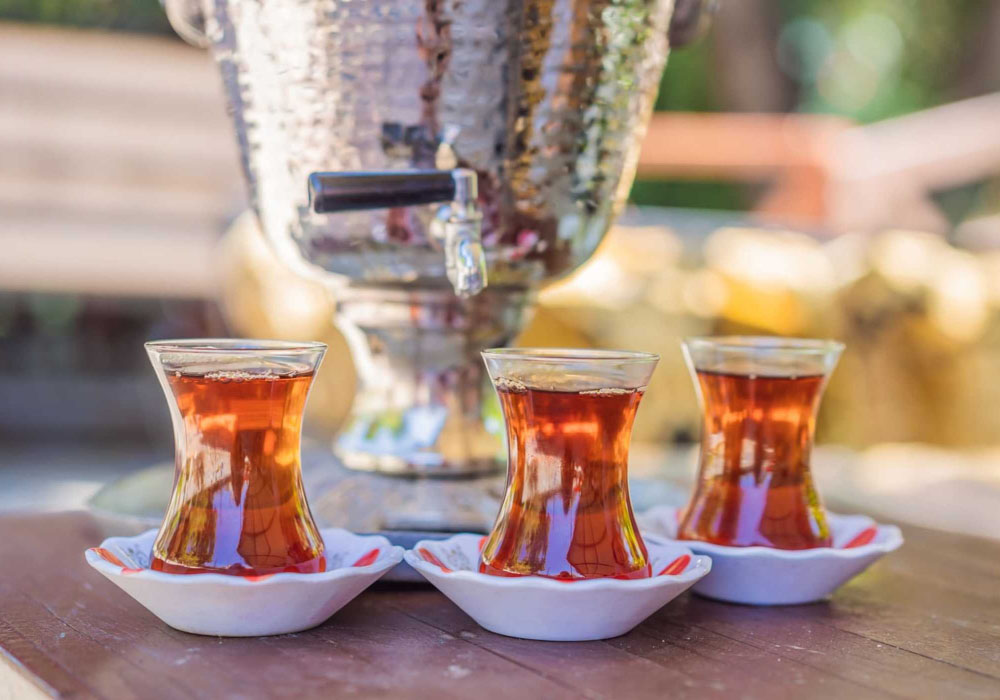
Turkish tea represents warmth and hospitality. It's a comforting presence in homes and public spaces alike.
Coffee rituals
Turkish coffee represents a ritual steeped in history. The coffee is finely ground and simmered in a small pot called a "cezve". It's served in small cups, allowing the grounds to settle at the bottom.
Coffee rituals involve:
- Preparing coffee to a frothy perfection.
- Serving with a glass of water to cleanse the palate.
- Offering Turkish delight or sweets alongside.
Turkish coffee is an art form. The preparation and serving are precise, ensuring an optimal experience. The grounds left in the cup are often used for fortune-telling. This adds a mystical element to the ritual, reflecting the cultural depth of this beloved beverage.
Ayran and raki
Ayran and Raki offer a refreshing contrast to tea and coffee. Ayran is a traditional yogurt-based drink. It's a simple blend of yogurt, water, and a pinch of salt. Ayran is often served cold, providing a creamy and tangy refreshment.
Raki, on the other hand, is known as "Lion's Milk". It's a strong, anise-flavoured alcoholic drink. When mixed with water, it forms a milky white solution that resembles milk. Raki is typically enjoyed during meals, especially with fish and meze.
Key differences between Ayran and Raki:
|
Beverage |
Type |
Common Pairings |
|---|---|---|
|
Ayran |
Non-alcoholic |
Kebabs, pide |
|
Raki |
Alcoholic |
Fish, meze |
Both drinks hold a special place in Istanbul's beverage culture. They are enjoyed across different settings, showcasing the diversity and richness of Turkish traditions.
Local markets: The soul of the city
Istanbul’s markets are much more than shopping destinations—they're cultural landmarks where flavours, traditions, and everyday life converge. Each market offers a unique glimpse into the city’s culinary heartbeat, from historic spice corridors to bustling neighbourhood stalls. With every scent, sound, and interaction, you experience a piece of Istanbul’s soul.
Spice Bazaar
Also known as the Egyptian Bazaar, the Spice Bazaar in Eminönü has been delighting visitors since the 1660s. This covered market is a sensory spectacle—its arched corridors are lined with mounds of saffron, cinnamon sticks, dried flowers, and jewel-toned Turkish delight.
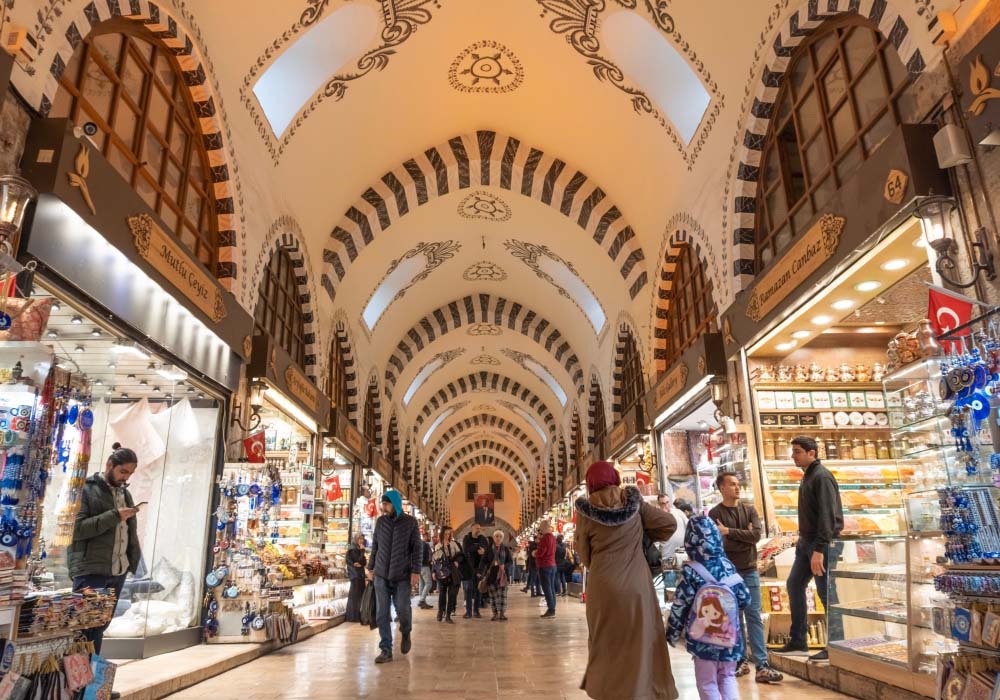
Beyond spices, you’ll find loose-leaf teas, artisanal honey, dried fruits, nuts, and herbal remedies steeped in tradition. The vendors are friendly and often eager to share samples, making it easy to immerse yourself in the flavours and fragrances that define Turkish cuisine.
- Best for: Spices, teas, Turkish delight.
- Tip: Arrive early for a more relaxed visit.
Kadıköy Market
Located on the Asian side of the city, Kadıköy Market is a vibrant neighbourhood bazaar beloved by locals for its authenticity and freshness. This open-air market is less touristy than its European counterparts, offering a relaxed yet energetic atmosphere where vendors greet regulars by name.
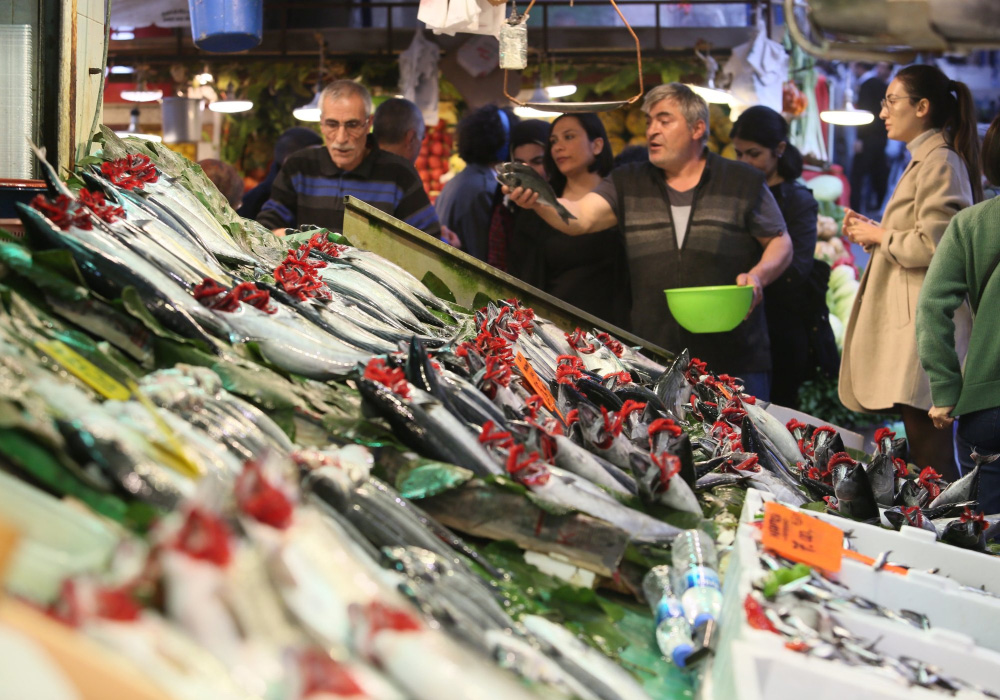
You’ll find seasonal produce stacked high in colourful displays, alongside artisanal cheeses, homemade jams, pickles, and olives from the Aegean region. Street food stalls tempt you with sizzling lahmacun, simit, and freshly made mezze. It’s also a great place to spot Istanbul’s evolving culinary scene, with gourmet bakeries and indie coffee shops nestled between fishmongers and butchers.
- Best for: Fresh ingredients, olives, cheeses, local eats.
- Bonus: Great for mingling with locals and discovering hidden cafés.
Grand Bazaar
The Grand Bazaar (Kapalıçarşı) is not only one of Istanbul’s most famous landmarks but also one of the world's oldest and largest covered markets. With over 4,000 shops spread across dozens of alleyways, it’s a labyrinth of commerce where you can find everything from antiques and textiles to jewellery, leather goods, and yes, delicious snacks.

While the Grand Bazaar is often known for carpets and gold, food lovers will find plenty to savour. Specialty stores sell baklava, dried apricots, spiced nuts, and Ottoman-era confections. It’s also a great place to stock up on locally packaged spices or artisanal sweets to take home.
- Try: Baklava, Turkish coffee, dried figs.
- Tip: Haggle, and don’t miss the quieter side alleys for better deals.
Dining experiences: From rooftops to taverns
Dining in Istanbul is about more than just what’s on your plate—it’s about the view, the atmosphere, and the cultural connection. Whether you're gazing out over the Bosphorus from a rooftop, sharing small plates in a centuries-old meyhane, or sipping third-wave coffee in a sleek café, every meal becomes a moment. The city’s dining landscape is as vibrant and diverse as its history, offering something for every taste and mood.
Rooftop restaurants
Elevate your experience—literally—with Istanbul’s dazzling rooftop restaurants. These venues offer panoramic views of the city’s skyline, the Golden Horn, or the Bosphorus, all while serving thoughtfully crafted cuisine. Ideal for a romantic dinner or an elegant evening with friends, they deliver both flavour and spectacle.
- Mikla: Located atop The Marmara Pera Hotel, Mikla remains a top-tier destination for fine dining, offering a unique blend of Nordic techniques and Anatolian ingredients with one of the best city views in town.
- 360 Istanbul: A stylish rooftop lounge with wraparound city views, 360 serves global fusion cuisine and is especially popular for dinner and late-night cocktails.
- Vogue Restaurant & Bar: Perched above Beşiktaş, this chic venue offers modern Mediterranean dishes and sushi, accompanied by stunning Bosphorus views.
Traditional mehanes
Mehanes are Istanbul’s beating heart when it comes to traditional dining. These convivial taverns are perfect for long, leisurely evenings filled with plates of meze, grilled meats or fish, and clinking glasses of rakı. Set to the backdrop of nostalgic tunes or live folk music, they embody the warm, communal spirit of Turkish dining.
- Kör Agop: A long-standing favourite in the Kumkapı district, this historic meyhane is loved for its generous hospitality, classic flavours, and occasional live music.
- Safa Meyhanesi: One of Istanbul’s oldest taverns (est. 1895), it’s revered for its timeless décor and traditional Armenian-Turkish mezze.
- Barba Vasilis: Located in the vibrant Fener-Balat district, this meyhane seamlessly blends Greek and Turkish tavern traditions in a laid-back, heritage-rich setting.
Contemporary cafés
Istanbul’s café culture has flourished in recent years, with a new generation of venues that combine modern aesthetics with artisanal values. These spaces serve as hubs for creatives, coffee lovers, and brunch enthusiasts alike. Expect everything from expertly pulled espresso to Turkish breakfast platters with a contemporary twist.
- Petra Roasting Co.: A leader in Istanbul’s third-wave coffee movement, Petra is renowned for its minimalist interiors, rotating roasts, and premium pour-over options.
- MOC Istanbul: Short for Ministry of Coffee, MOC combines Australian café culture with Turkish flair, offering excellent coffee alongside a globally inspired food menu.
Fine dining
For those seeking refinement and culinary artistry, Istanbul’s fine dining scene delivers in style. These establishments highlight the city’s evolving gastronomy, merging local traditions with international trends and high-end techniques. Perfect for special occasions or indulgent nights out.
- Ulus 29: With sweeping views of the Bosphorus and a menu that fuses Turkish and European flavours, this glamorous restaurant offers a luxurious dining experience.
- St. Regis Brasserie: Situated within the prestigious St. Regis Hotel, this brasserie serves upscale international cuisine in an elegant, art deco-inspired setting.
Final thoughts
Exploring Istanbul through food is more than a culinary journey—it’s a cultural experience. Each bite connects you to centuries of tradition, community stories, and the city’s unique geography, which straddles two continents. From simit at sunrise to künefe under the stars, Istanbul’s food scene awakens all your senses.
Whether you're sipping tea in a quiet garden, sharing meze in a bustling tavern, or navigating the aromatic chaos of a spice bazaar, every experience adds another delicious layer to your journey. Istanbul doesn’t just feed your stomach—it feeds your soul. Let this city’s flavours lead you through its past, present, and future, one unforgettable meal at a time.

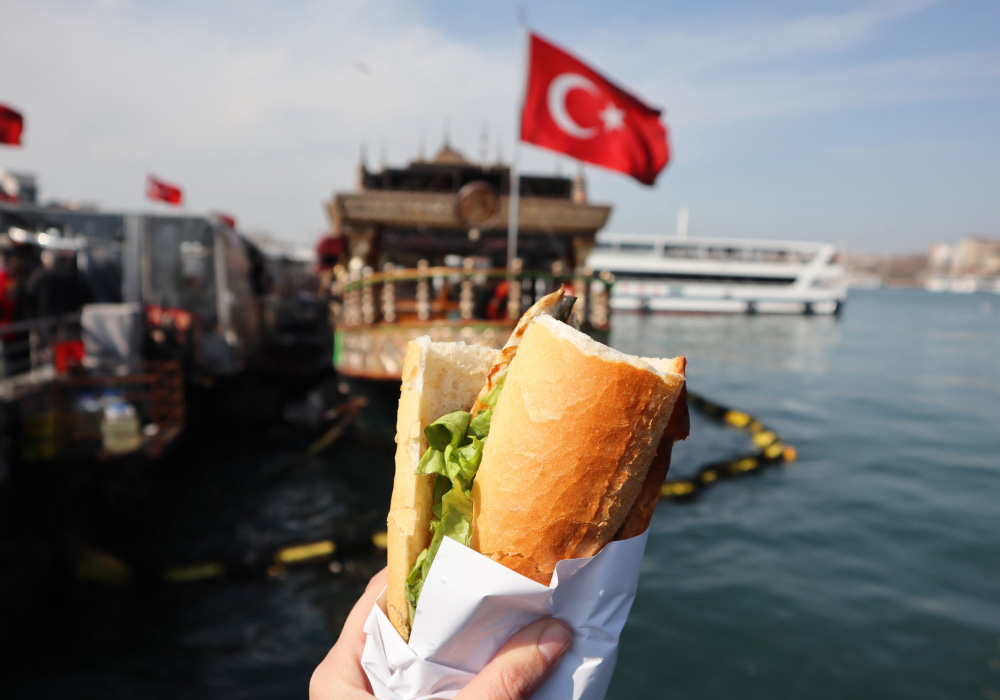


Comments powered by CComment